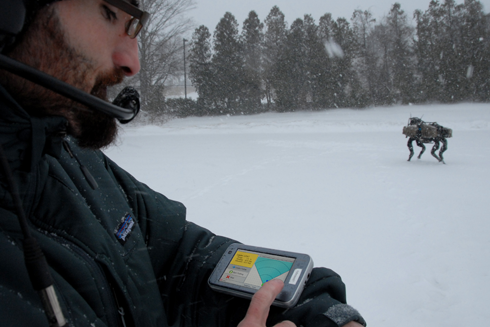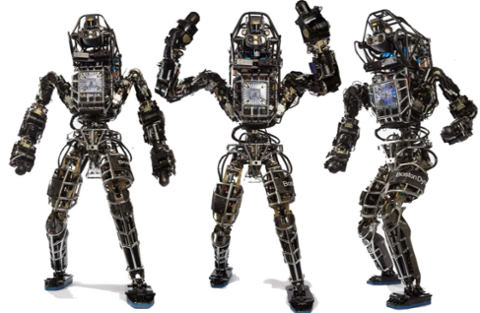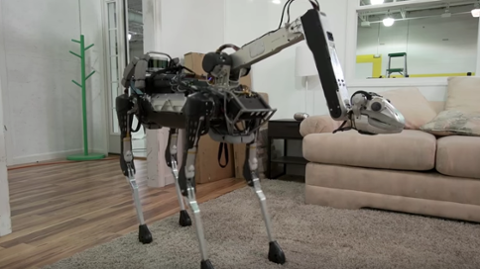 A Boston Dynamics robot tromping through the snow.[/caption] Google has just acquired robotics firm Boston Dynamics, creator of four-legged machines (such as the BigDog and Cheetah) capable of rapid speed over uneven terrain. Start your Skynet jokes now, everyone. Kidding aside, Boston Dynamics has done quite a bit to advance the cause of “real world” robotics over the past few years. Its BigDog robot, for example, is a 240-pound quadruped loaded with a variety of sensors that allow it to monitor both the outside environment and its internal state; the machine can maneuver over rubble, mud, snow, and shallow water. The company has also experimented with robots capable of scaling vertical surfaces, walking upright on two legs, and sprinting at up to 29 mph. Google hasn’t revealed how much it paid for Boston Dynamics, nor what it plans to do with all those robots. Also up in the air is how the acquisition will affect Boston Dynamics’ long-term relationships with DARPA and other firms. What’s clear is that Google intends to do something meaningful in the robotics field. Boston Dynamics makes the eighth robot-building company acquired by Google over the past year; Andy Rubin, the high-ranking Google executive who guided the development of the Android operating system, is heading up the effort, which he recently described to The New York Times as a “moonshot” akin to Google’s endeavors in self-driving cars and Google Glass. “I feel with robotics it’s a green field,” Rubin added. “We’re building hardware, we’re building software. We’re building systems, so one team will be able to understand the whole stack.” There’s also the possibility that Google robotics could make their debut in the nearer term, perhaps as a labor-saving element in manufacturing or product delivery. Google clearly wouldn’t need a four-legged robot capable of wading through a whitewater creek to deliver packages, but Boston Dynamics has done a lot of work in hardware sensors, mechanical locomotion, and other crucial areas—research that could be adapted to any number of uses. At the very least, Google could use the Boston Dynamics robots’ spectacular brick-hurling abilities to knock some Amazon delivery drones out of the sky. Image: Boston Dynamics
A Boston Dynamics robot tromping through the snow.[/caption] Google has just acquired robotics firm Boston Dynamics, creator of four-legged machines (such as the BigDog and Cheetah) capable of rapid speed over uneven terrain. Start your Skynet jokes now, everyone. Kidding aside, Boston Dynamics has done quite a bit to advance the cause of “real world” robotics over the past few years. Its BigDog robot, for example, is a 240-pound quadruped loaded with a variety of sensors that allow it to monitor both the outside environment and its internal state; the machine can maneuver over rubble, mud, snow, and shallow water. The company has also experimented with robots capable of scaling vertical surfaces, walking upright on two legs, and sprinting at up to 29 mph. Google hasn’t revealed how much it paid for Boston Dynamics, nor what it plans to do with all those robots. Also up in the air is how the acquisition will affect Boston Dynamics’ long-term relationships with DARPA and other firms. What’s clear is that Google intends to do something meaningful in the robotics field. Boston Dynamics makes the eighth robot-building company acquired by Google over the past year; Andy Rubin, the high-ranking Google executive who guided the development of the Android operating system, is heading up the effort, which he recently described to The New York Times as a “moonshot” akin to Google’s endeavors in self-driving cars and Google Glass. “I feel with robotics it’s a green field,” Rubin added. “We’re building hardware, we’re building software. We’re building systems, so one team will be able to understand the whole stack.” There’s also the possibility that Google robotics could make their debut in the nearer term, perhaps as a labor-saving element in manufacturing or product delivery. Google clearly wouldn’t need a four-legged robot capable of wading through a whitewater creek to deliver packages, but Boston Dynamics has done a lot of work in hardware sensors, mechanical locomotion, and other crucial areas—research that could be adapted to any number of uses. At the very least, Google could use the Boston Dynamics robots’ spectacular brick-hurling abilities to knock some Amazon delivery drones out of the sky. Image: Boston Dynamics Google Acquires Robotics-Maker Boston Dynamics
[caption id="attachment_15219" align="aligncenter" width="490"]  A Boston Dynamics robot tromping through the snow.[/caption] Google has just acquired robotics firm Boston Dynamics, creator of four-legged machines (such as the BigDog and Cheetah) capable of rapid speed over uneven terrain. Start your Skynet jokes now, everyone. Kidding aside, Boston Dynamics has done quite a bit to advance the cause of “real world” robotics over the past few years. Its BigDog robot, for example, is a 240-pound quadruped loaded with a variety of sensors that allow it to monitor both the outside environment and its internal state; the machine can maneuver over rubble, mud, snow, and shallow water. The company has also experimented with robots capable of scaling vertical surfaces, walking upright on two legs, and sprinting at up to 29 mph. Google hasn’t revealed how much it paid for Boston Dynamics, nor what it plans to do with all those robots. Also up in the air is how the acquisition will affect Boston Dynamics’ long-term relationships with DARPA and other firms. What’s clear is that Google intends to do something meaningful in the robotics field. Boston Dynamics makes the eighth robot-building company acquired by Google over the past year; Andy Rubin, the high-ranking Google executive who guided the development of the Android operating system, is heading up the effort, which he recently described to The New York Times as a “moonshot” akin to Google’s endeavors in self-driving cars and Google Glass. “I feel with robotics it’s a green field,” Rubin added. “We’re building hardware, we’re building software. We’re building systems, so one team will be able to understand the whole stack.” There’s also the possibility that Google robotics could make their debut in the nearer term, perhaps as a labor-saving element in manufacturing or product delivery. Google clearly wouldn’t need a four-legged robot capable of wading through a whitewater creek to deliver packages, but Boston Dynamics has done a lot of work in hardware sensors, mechanical locomotion, and other crucial areas—research that could be adapted to any number of uses. At the very least, Google could use the Boston Dynamics robots’ spectacular brick-hurling abilities to knock some Amazon delivery drones out of the sky. Image: Boston Dynamics
A Boston Dynamics robot tromping through the snow.[/caption] Google has just acquired robotics firm Boston Dynamics, creator of four-legged machines (such as the BigDog and Cheetah) capable of rapid speed over uneven terrain. Start your Skynet jokes now, everyone. Kidding aside, Boston Dynamics has done quite a bit to advance the cause of “real world” robotics over the past few years. Its BigDog robot, for example, is a 240-pound quadruped loaded with a variety of sensors that allow it to monitor both the outside environment and its internal state; the machine can maneuver over rubble, mud, snow, and shallow water. The company has also experimented with robots capable of scaling vertical surfaces, walking upright on two legs, and sprinting at up to 29 mph. Google hasn’t revealed how much it paid for Boston Dynamics, nor what it plans to do with all those robots. Also up in the air is how the acquisition will affect Boston Dynamics’ long-term relationships with DARPA and other firms. What’s clear is that Google intends to do something meaningful in the robotics field. Boston Dynamics makes the eighth robot-building company acquired by Google over the past year; Andy Rubin, the high-ranking Google executive who guided the development of the Android operating system, is heading up the effort, which he recently described to The New York Times as a “moonshot” akin to Google’s endeavors in self-driving cars and Google Glass. “I feel with robotics it’s a green field,” Rubin added. “We’re building hardware, we’re building software. We’re building systems, so one team will be able to understand the whole stack.” There’s also the possibility that Google robotics could make their debut in the nearer term, perhaps as a labor-saving element in manufacturing or product delivery. Google clearly wouldn’t need a four-legged robot capable of wading through a whitewater creek to deliver packages, but Boston Dynamics has done a lot of work in hardware sensors, mechanical locomotion, and other crucial areas—research that could be adapted to any number of uses. At the very least, Google could use the Boston Dynamics robots’ spectacular brick-hurling abilities to knock some Amazon delivery drones out of the sky. Image: Boston Dynamics
 A Boston Dynamics robot tromping through the snow.[/caption] Google has just acquired robotics firm Boston Dynamics, creator of four-legged machines (such as the BigDog and Cheetah) capable of rapid speed over uneven terrain. Start your Skynet jokes now, everyone. Kidding aside, Boston Dynamics has done quite a bit to advance the cause of “real world” robotics over the past few years. Its BigDog robot, for example, is a 240-pound quadruped loaded with a variety of sensors that allow it to monitor both the outside environment and its internal state; the machine can maneuver over rubble, mud, snow, and shallow water. The company has also experimented with robots capable of scaling vertical surfaces, walking upright on two legs, and sprinting at up to 29 mph. Google hasn’t revealed how much it paid for Boston Dynamics, nor what it plans to do with all those robots. Also up in the air is how the acquisition will affect Boston Dynamics’ long-term relationships with DARPA and other firms. What’s clear is that Google intends to do something meaningful in the robotics field. Boston Dynamics makes the eighth robot-building company acquired by Google over the past year; Andy Rubin, the high-ranking Google executive who guided the development of the Android operating system, is heading up the effort, which he recently described to The New York Times as a “moonshot” akin to Google’s endeavors in self-driving cars and Google Glass. “I feel with robotics it’s a green field,” Rubin added. “We’re building hardware, we’re building software. We’re building systems, so one team will be able to understand the whole stack.” There’s also the possibility that Google robotics could make their debut in the nearer term, perhaps as a labor-saving element in manufacturing or product delivery. Google clearly wouldn’t need a four-legged robot capable of wading through a whitewater creek to deliver packages, but Boston Dynamics has done a lot of work in hardware sensors, mechanical locomotion, and other crucial areas—research that could be adapted to any number of uses. At the very least, Google could use the Boston Dynamics robots’ spectacular brick-hurling abilities to knock some Amazon delivery drones out of the sky. Image: Boston Dynamics
A Boston Dynamics robot tromping through the snow.[/caption] Google has just acquired robotics firm Boston Dynamics, creator of four-legged machines (such as the BigDog and Cheetah) capable of rapid speed over uneven terrain. Start your Skynet jokes now, everyone. Kidding aside, Boston Dynamics has done quite a bit to advance the cause of “real world” robotics over the past few years. Its BigDog robot, for example, is a 240-pound quadruped loaded with a variety of sensors that allow it to monitor both the outside environment and its internal state; the machine can maneuver over rubble, mud, snow, and shallow water. The company has also experimented with robots capable of scaling vertical surfaces, walking upright on two legs, and sprinting at up to 29 mph. Google hasn’t revealed how much it paid for Boston Dynamics, nor what it plans to do with all those robots. Also up in the air is how the acquisition will affect Boston Dynamics’ long-term relationships with DARPA and other firms. What’s clear is that Google intends to do something meaningful in the robotics field. Boston Dynamics makes the eighth robot-building company acquired by Google over the past year; Andy Rubin, the high-ranking Google executive who guided the development of the Android operating system, is heading up the effort, which he recently described to The New York Times as a “moonshot” akin to Google’s endeavors in self-driving cars and Google Glass. “I feel with robotics it’s a green field,” Rubin added. “We’re building hardware, we’re building software. We’re building systems, so one team will be able to understand the whole stack.” There’s also the possibility that Google robotics could make their debut in the nearer term, perhaps as a labor-saving element in manufacturing or product delivery. Google clearly wouldn’t need a four-legged robot capable of wading through a whitewater creek to deliver packages, but Boston Dynamics has done a lot of work in hardware sensors, mechanical locomotion, and other crucial areas—research that could be adapted to any number of uses. At the very least, Google could use the Boston Dynamics robots’ spectacular brick-hurling abilities to knock some Amazon delivery drones out of the sky. Image: Boston Dynamics 
